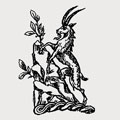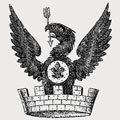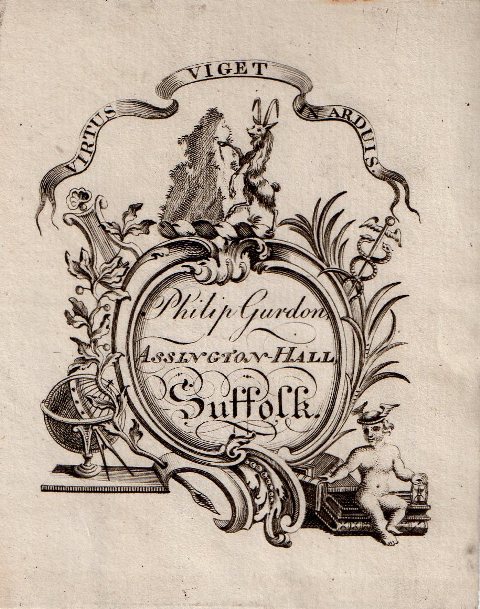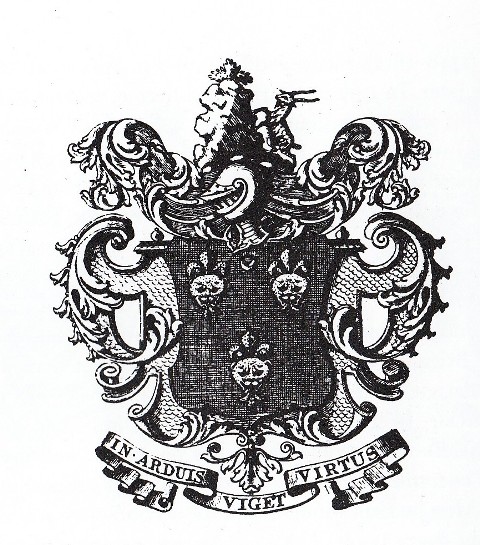Gurdon Family Crests. Which Gurdon is your family?
You searched for 'Gurdon', but there are 7 families with that name in our historic records. Do you know where your family came from, recognise the name of an ancestor or see your crest? If so, please click on your family from the list below..
SELECT YOUR CREST TO SEE AVAILABLE SILVER
AND REGISTER FOR SALE ALERTS
-
 Gurdon
Gurdon
Hampshire, Suffolk, and Wiltshire
Select
-
 Gurdon
Gurdon
Norfolk and Suffolk
"In arduis viget virtus"
Select
-
 Gurdon
Gurdon
Sir William Brampton, K.C.M.G., of Assington Hall,…
"In arduis viget virtus"
Select
-
 Gurdon
Gurdon
Major-General Evelyn Pulteney, of 12, Norton Road,…
"In arduis viget virtus"
Select
-
 Gurdon
Gurdon
Philip, Esquire, of 6, Conduit Road, Bedford
"In arduis viget virtus"
Select
-
 Gurdon-Rebow
Gurdon-Rebow
Hector John, of Wyvenhoe Park, Essex:
Select
-
 Gurdon-Rebow
Gurdon-Rebow
Hector John, of Wyvenhoe Park, Essex:
Select
Gurdon
Gurdon
Gurdon Family History
According to Burkes Landed Gentry (1879 edition) “This family came into England with The Conqueror, from Gourdon, near Cahors, on the borders of Perigord, and the name is on the Roll of Battle Abbey.”
According to the family Bertram de Gurdon “in 1199 shot King Richard the First (The Lion Heart) with an arrow from the walls of the Castle of Chalus in France, of which wound the King afterwards died, but he first forgave Bertram reflecting on his own avaricious undertaking.”
His son “Adam de Gurdon: d.1214, Kings Serjeant and mercenary for king John.”
His son “Sir Adam de Gurdon: d. 1231, Had land in Tystede.”
His son “Sir Adam de Gurdon: of Shropshire: d. 1310, Justice Itinerant. One of the most famous men of the Middle Ages, it has been said that the legend of Robin Hood has been based on part of de Gurdon’s life. He was knighted on 28 May 1254 by King Henry III. He was Bailiff of Alton but was outlawed for treason and rebellion as one of the adherents of Simon, Earl of Leicester. After the Battle of Evesham he retired with his band of followers into the New Forest between Wilton and Fernham, from his base there no traveller was safe. In 1273 he was defeated in single combat by Prince Edward, later King Edward I, in one of the most celebrated deeds of that age. Prince Edward, who was pleased with de Gurdon’s bravery, pardoned him. He was then appointed keeper of the Forest of Wolner and employed in high military commands. He resided at the Temple, Selborne in Hampshire, now occupied by the Earl of Selborne.”
This accords with the entry in Burkes Landed Gentry which states that “Sir Adam de Gurdon, knt., living in the time of Henry III, was in that monarch’s reign, bailiff of Alton, but was outlawed for treason and rebellion, as one of the Montfort faction. He was restored, however, upon the accession of Edward, and constituted, 1272, Keeper of the forest of Wolmer. He married 1st, Constantia, daughter and heiress of Thomas Makarel of Selborne, Southampton. He resided in that Shire in a mansion house, called The Temple, which overlooked the forest. Sir Adam married a second wife, named Almeria, from whom he was divorced, after having had two sons, the elder of whom was seated in Wiltshire, and the younger settled himself in London. These sons appear, however, to have been disinherited, for their father had a 3rd wife, Agnes and by her a daughter, Johanna, to whom he left his property in Selbourne. This lady married Richard Achard, and that estate, bearing still the name of Gurdon Manor, belongs now to Magdalen College, Oxford. The armorial ensigns of Sir Adam Gurdon are still borne by the family...”
The Gurdon arms being a sable (black) shield charged with three leopard's faces jessant de lys. This means that they are facing towards the viewer and have a fleur de lys behind them.
The younger son, Robert Gurdon, became Sheriff of London and died in 1343. He founded a line of merchants (mostly named John) based in London, Clyne in Kent and Dedham in Essex. His great, great, great, great, great grandson, Robert Gurdon Esq. (died 1577), married Rose, daughter and heiress of Robert Sexton, Esq, of Lavenham, Suffolk. He purchased Assington Hall from Sir Miles Corbet; and served as Sheriff of Suffolk.
His son, John Gurdon Esq. (died 1623), of Assington was High Sheriff of Suffolk in 1585 and married Amy, daughter and heiress of William Brampton Esq., of Letton, Norfolk.
He was succeeded by his son, Brampton Gurdon, Esq. (died 1649), of Assington Hall and of Letton. He was High Sheriff of Suffolk in 1625 and MP for Sudbury. He married 1stly Elizabeth, daughter of Edward Barrett Esq., of Bell House, Essex (who claimed descent from King Henry I); he married 2ndly Muriel, daughter of Sir Martyn Sedley of Morley, Norfolk (by a daughter of John Knyvett of Ashwellthorpe). He was succeeded at Assington by his eldest son, John, and at Letton by a younger son, Brampton.
John Gurdon Esq., of Assington (died 1679) was MP for Suffolk in the Long Parliament, and one of the Committee appointed to sit in judgement upon Charles I, but he did not attend the trial and more importantly he did not sign the judgement and thus escaped the unfortunate fate of the other regicides. Oliver Cromwell was his guest at Assington during the siege of Colchester.
Brampton Gurdon Esq., of Letton (died 1669) was MP for Ipswich from 1640-1654 and served as Colonel of a regiment of horse during the civil war and at the siege of Colchester.
From each of these sons descended the branches of the family treated separately by Burkes Landed Gentry as Gurdon of Assington and Gurdon of Letton.
Gurdon of Assington

The bookplate above was commissioned by Rev Philip Gurdon (1753-1817) who inherited Assington from his first cousin John Gurdon in 1758.
The Gurdon’s of Assington were the senior line and continued at Assington for many generations, with many members of the family following careers in the church and one more MP for Sudbury (John Gurdon – died 1758).
Assington Church itself, rebuilt by John Gurdon Esq., of Assington (1791-1869) is full of family memorials and visitors have often noted the family fondness for decorating the monuments with winged skulls (also known as "Death heads"). Now popularly recognised as the "hells angels" symbol (The Hells Angels corporation even attempted to sue designer Alexander McQueen for breach of their trademark when in 2010 he used the winged skull in his final collection) the winged skull is a traditional "momento mori", used as a reminder of human mortality. The image was particularly popular with puritans (and is consequently common in graveyards on the east coast of the USA) and the use by the Gurdons is probably a result of their puritanical and parliamentary allegiances during the civil war.
Philip and John appear to have been the most popular christian names for Gurdon men of the Assington branch.
Philip Gurdon (1859-1942) succeeded his grandfather at Assington in 1869 and at some point sold the estate to his distant cousin Rt. Hon.Sir William Brampton Gurdon, KCMG, CB, PC (1840-1910), younger brother of 1st Lord Cranworth of the Letton branch. Subsequent to Sir William’s death (without issue) Assington was acquired by another long established Suffolk family by the name of Frere before burning down in 1957. The Gurdon’s of Assington last appearing in the 1921 Edition of Burkes Landed Gentry.
Assington Hall was a fine Elizabethan house described in “Burke’s and Savills Guide to Country Houses : Volume III – East Anglia” (1981) edited by the late, esteemed, Hugh Montgomery Massingberd as “Late C16 brick house with projected battlemented porch, five pointed gables and sashed windows. Polygonal angle buttresses and clusters of brick chimneys with star tops.”
It also appeared in Country Life (cxxviii).
Fortunately the main contents were sold with the house to Sir William Gurdon and most are now in the possession of Lord Cranworth at Grundisburgh and thus escaped the fire.
The most senior member of this family is Philip Gurdon’s grandson, the 2012 Nobel Prize winner, Professor Sir John Bertrand Gurdon, FRS. Born in 1933, Sir John is a distinguished developmental biologist and former Master of Magdalene College, Cambridge. His scientific ambitions were famously dismissed by a schoolmaster at Eton, where he was bottom out of 250 in Biology, in a report with the words “...on his present showing this is quite ridiculous.”
Gurdon of Letton
The Gurdon’s of Letton descend from Brampton Gurdon Esq., Barrister at Law and MP for Ipswich, 1640-1654, younger son of Brampton Gurdon of Assington and Letton, from whom he inherited the old Brampton estate of Letton. He married Mary, daughter of Henry Polstead Esq of London and succeeded by by his son, Brampton Gurdon.
This Brampton Gurdon married Elizabeth, daughter of Col Thornhaugh, of Fenton, Nottinghamshire, son of Sir Francis Thornhagh and died in 1691.
He was succeeded by his son, Thornhagh Gurdon Esq., of Letton, Receiver General of Norfolk in the time of Queen Anne and author of "The origin and rights of parliament". He married Elizabeth, daughter and co-heiress of Sir William Cooke, Bart., of Brome Hall, Norfolk; and died 1713 being succeeded by his son, Thornhagh Gurdon.
Thornhagh Gurdon Esq., of Letton (1700-1783) married Sarah, daughter and heiress of Theophilius Dillingham Esq. of Shelton, Bedfordshire and commissioned the bookplate shown below.

His son, Brampton Gurdon (died 1820), was the first of the family to have been described as “of Letton, Norfolk and Grundisburgh, Suffolk”, having purchased Grundisburgh in 1771. He took the surname Dillingham on inheriting the estate of his maternal grandfather and commissioned Sir John Soane to build a new Hall at Letton and this is described in “Burke's and Savills Guide to Country Houses – Volume III, East Anglia” as “..surviving largely unaltered. Important as Soane’s first major house and already containing the seeds of his austere personal style.”
He was succeeded by his son, Theophilus Thornhagh Gurdon Esq., of Letton, Norfolk and Grundisburgh, Suffolk who does not appear to have taken the Dillingham surname.
This branch of the family maintained the political tradition and Robert Thornhaugh Gurdon (1829-1944) of Letton was MP for South Norfolk and then Mid Norfolk from 1880-1892. He was elevated to the peerage as 1st Baron Cranworth of Letton and Cranworth in 1899.
Lord Cranworth sold the Letton estate in 1917 whereupon the Grundisburgh estate became the main family seat
Several junior branches of the Gurdons of Letton established estates in East Anglia and Burkes Landed Gentry 1969 edition records one such, Gurdon of Burgh House.
SNBM